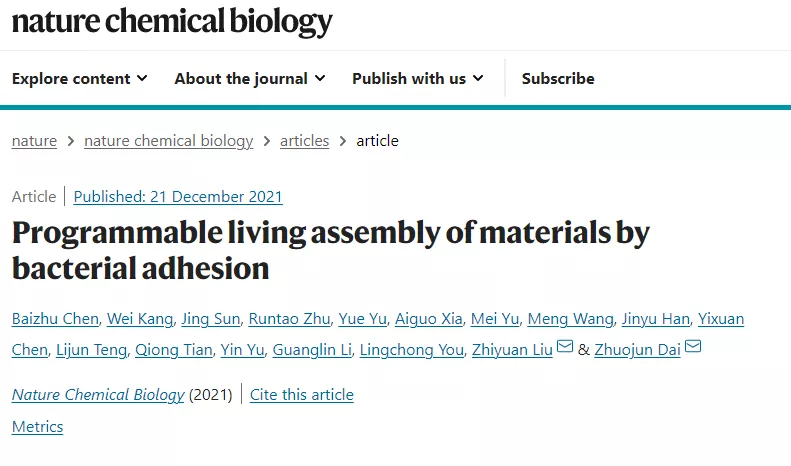Nature Chemical Biology: The collision between BT and IT?
- Statins Lower Blood Lipids: How Long is a Course?
- Warning: Smartwatch Blood Sugar Measurement Deemed Dangerous
- Mifepristone: A Safe and Effective Abortion Option Amidst Controversy
- Asbestos Detected in Buildings Damaged in Ukraine: Analyzed by Japanese Company
- New Ocrevus Subcutaneous Injection Therapy Shows Promising Results in Multiple Sclerosis Treatmen
- Dutch Man Infected with COVID-19 for 613 Days Dies: Accumulating Over 50 Virus Mutations
Nature Chemical Biology: The collision between BT and IT?
Nature Chemical Biology: The collision between BT and IT?
The Dai Zhuojun/Liu Zhiyuan team of Shenzhen Advanced Institute designed fast and self-healing living materials
On December 21, 2021, the Institute of Synthesis, Shenzhen Institute of Advanced Technology, Chinese Academy of Sciences, the Dai Zhuojun group of Shenzhen Institute of Synthesis and the Liu Zhiyuan group of the Institute of Integration , published an article titled Programmable Living Material Generated by Bacterial Assembly in Nature Chemical Biology .
Aiming at the field of living body functional materials, a brand-new idea of constructing living body materials that can quickly and self-healing is proposed, and this idea is further transformed into a universal method of living body material combination, and it is popularized in brand-new fields such as intelligence.
Manufacturing and assembly of wearable devices, a preliminary attempt at the integration of biotechnology (BT) + information technology (IT) .
The design concept goes beyond the current editing framework of living materials based on biofilms, and uses the concept of polymer physics and chemistry to interdisciplinary research and challenge the use of microorganisms to prepare programmable and processable living functional materials with rapid self-repair characteristics.
The first author is Dr. Chen Baizhu, and the second authors Sun Jing and Zhu Runtao have made important contributions to the part of wearable devices and the revision of the article.
Why is Ta?
Since the concept of living materials was proposed in 2014, most of the work so far has been to achieve material assembly through editing engineering biofilm engineering , and the most mature of which is the E. coli amyloid fiber (curli) system.
The Curli system consists of protein monomer CsgA riveting and polymerizing on the surface of bacteria to form fibers. By fusing peptides or protein functional domains with CsgA, curli can be endowed with diversified functions.
However, due to the limitation of secretion, CsgA can only fuse a protein of about 100 amino acids, which limits the scope of curli functional modification.
In addition, self-healing is another core advantage of living materials.
At present, the self-repair of living materials all relies on the growth and renewal of bacteria themselves.
Even the fast-dividing Escherichia coli, the time scale for self-repair is between a few to tens of hours.
For wearable devices for health monitoring, the material must quickly repair its performance after being stretched or folded to ensure the stability of the device’s operation.
For example, the sensitivity, reliability, and stability of strain sensors in wearable devices depend on the conductive network and mechanical properties of the material after repair.
The self-healing requirements of such materials are usually on the order of minutes.
Therefore, the theoretical self-repair capability of current living materials differs from the actual demand by a hundred times or even a thousand times.
Relying solely on the original ideas of synthetic biology: The self-repairing effect brought by biological growth cannot solve this problem.
It is urgent to introduce interdisciplinary concepts and designs to provide new thinking and new methods.
LAMBA: Living Assembled Material by Bacteria Assembly
In a class of synthetic polymer materials, rapid and multiple self-repair can be achieved through the chemical action of non-covalent bonds.
This kind of self-repair based on dynamic non-covalent chemical action is mainly through the host-guest action such as hydrogen bonds.
In biological macromolecules, antigen and antibody can be combined through non-covalent bonds, including hydrogen bonds, electrostatic interactions, hydrophobic interactions, and so on.
As a result, by editing antigen or antibody molecules on the surface of microorganisms, this work guides microorganisms to generate adhesion through antigen-antibody interactions, thereby forming a living functional material that can quickly self-repair and building a new framework for the design of living functional materials (Figure 1 ) .
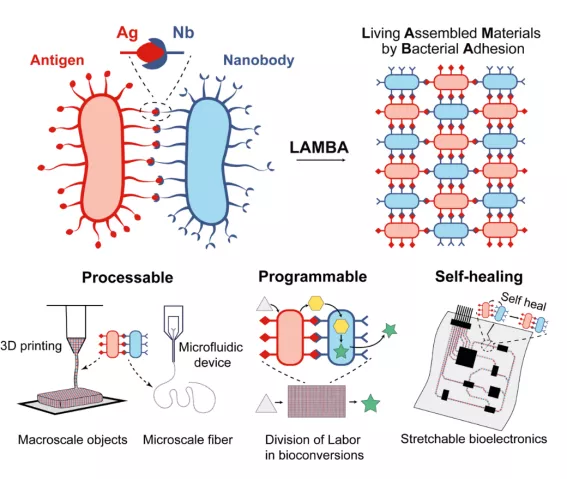 Figure 1: Assemble LAMBA living body functional materials to make the materials processable, programmable, and self-healing quickly
Figure 1: Assemble LAMBA living body functional materials to make the materials processable, programmable, and self-healing quickly
Researchers use the developed antigen or antibody and surface display system3.
The antigen or antibody is displayed on the surface of the E. coli cell membrane to construct engineered bacteria, and then the two bacterial construction materials are mixed. T
he mixed bacteria quickly self-assemble into a material precursor due to the action of antigen and antibody (LAMBA, Figure 2a) .
LAMBA has a higher dynamic modulus and viscosity than a single species of bacteria.
This optimized rheological properties makes LAMBA better processability (Figure 2b) .
LAMBA can be used directly as a 3D printing material to build macroscopic two-dimensional or three-dimensional fine structures (Figure 2c) , and it can also build micron-level materials, such as assembling micron-level fibers (Figure 2d) .
As a living material, LAMBA has the growth characteristics of “living” materials. By “copying” LAMBA, new materials can be copied and produced, and the new materials can still maintain a good shape and integrity (Figure 2e) .

Figure 2: LAMBA is processable. a: After the E. coli displaying antigens and antibodies are mixed, they self-assemble and settle to form LAMBA; b: the viscosity of LAMBA is significantly improved; c: LAMBA builds two-dimensional or three-dimensional macroscopic fine structure; d: builds micron-level LAMBA fibers: e: LAMBA can be reproduced with high fidelity.
Programmable LAMBA
Scientists use synthetic biology tools to program LAMBA to give it the function of biodegradation or biocatalysis:
1) Biodegradable LAMBA:
Researchers simultaneously display organophosphorus pesticide degrading enzymes (OPH) on the surface of the bacteria displaying the antigen , and modify the gold nanoparticles on the surface of the bacteria displaying the antibody (Figure 3a) .
Use two kinds of bacteria to bond together to make living material.
Experimental data shows that under the catalysis of OPH, the assembled living material first converts paraoxon into an intermediate product, p-nitrophenol, and is further catalyzed by nano-gold particles to be degraded into low-toxic p-aminophenol (Figure 2b) .
2) Biocatalyzable LAMBA:
Researchers simultaneously display starch hydrolase (BA) on the surface of the bacteria displaying the antigen , and express trehalose synthase (TreS) in the cells of the bacteria displaying the antibody , using two kinds of bacteria to bond together to make living materials (Figure 3c) .
Starch, as a carbon source that cannot be used by E. coli, can first be converted into maltose by starch hydrolyzing enzymes, transported into the cell as a substrate, and converted into trehalose by trehalose synthase (Figure 3d) .
It is worth mentioning that researchers can use the protein display system to display 545 amino acid functional domains on the surface of LAMBA to improve the modification ability of living functional materials.
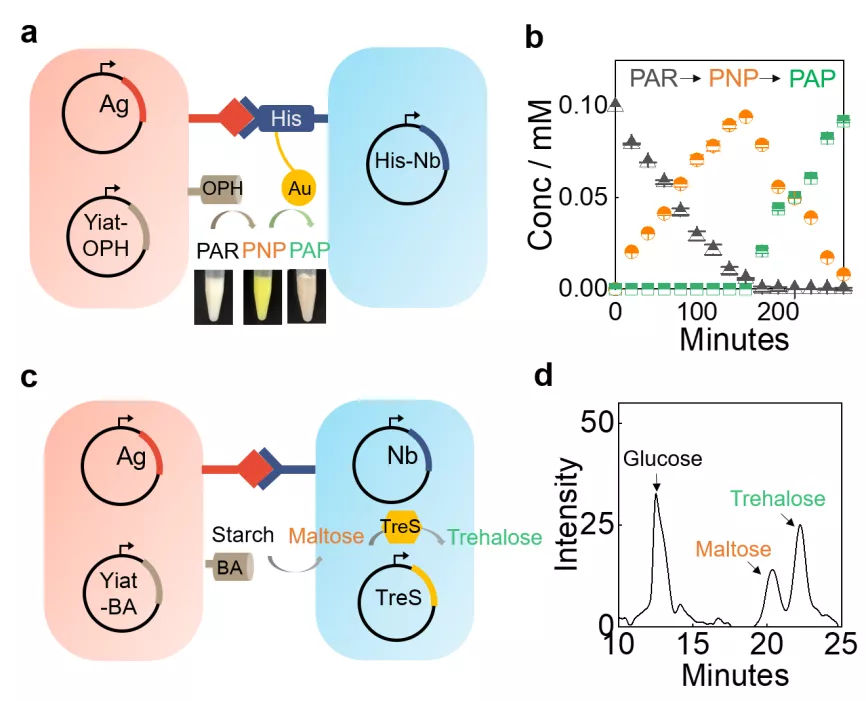 Figure 3: Programmable LAMBA. ab: Through programming, the LAMBA material has the ability to degrade paraoxon; cd: through programming, the LAMBA material has the ability to synthesize trehalose.
Figure 3: Programmable LAMBA. ab: Through programming, the LAMBA material has the ability to degrade paraoxon; cd: through programming, the LAMBA material has the ability to synthesize trehalose.
Wearable LAMBA flexible device
Researchers hope that through the non-covalent interaction of antigens and antibodies, LAMBA has the ability to quickly self-repair.
To this end, LAMBA is placed on a stretchable SEBS film, and cyclically stretched to 250% of its length, while tracking its electrical conductivity.
The data shows that LAMBA always maintains a constant resistance under this cyclic stretching (10 times) , while the resistance of a single species of bacteria increases rapidly when it is stretched.
Scientists cut the material from the middle of the bacteria, kneaded the sections within five minutes and immediately repeated the stretching experiment (Figure 4a) .
The data shows that LAMBA still maintains a constant resistance under cyclic stretching after repair, while the resistance of a single species of bacteria is significantly increased, indicating that the LAMBA device has rapid self-healing ability (Figure 4b-c) .
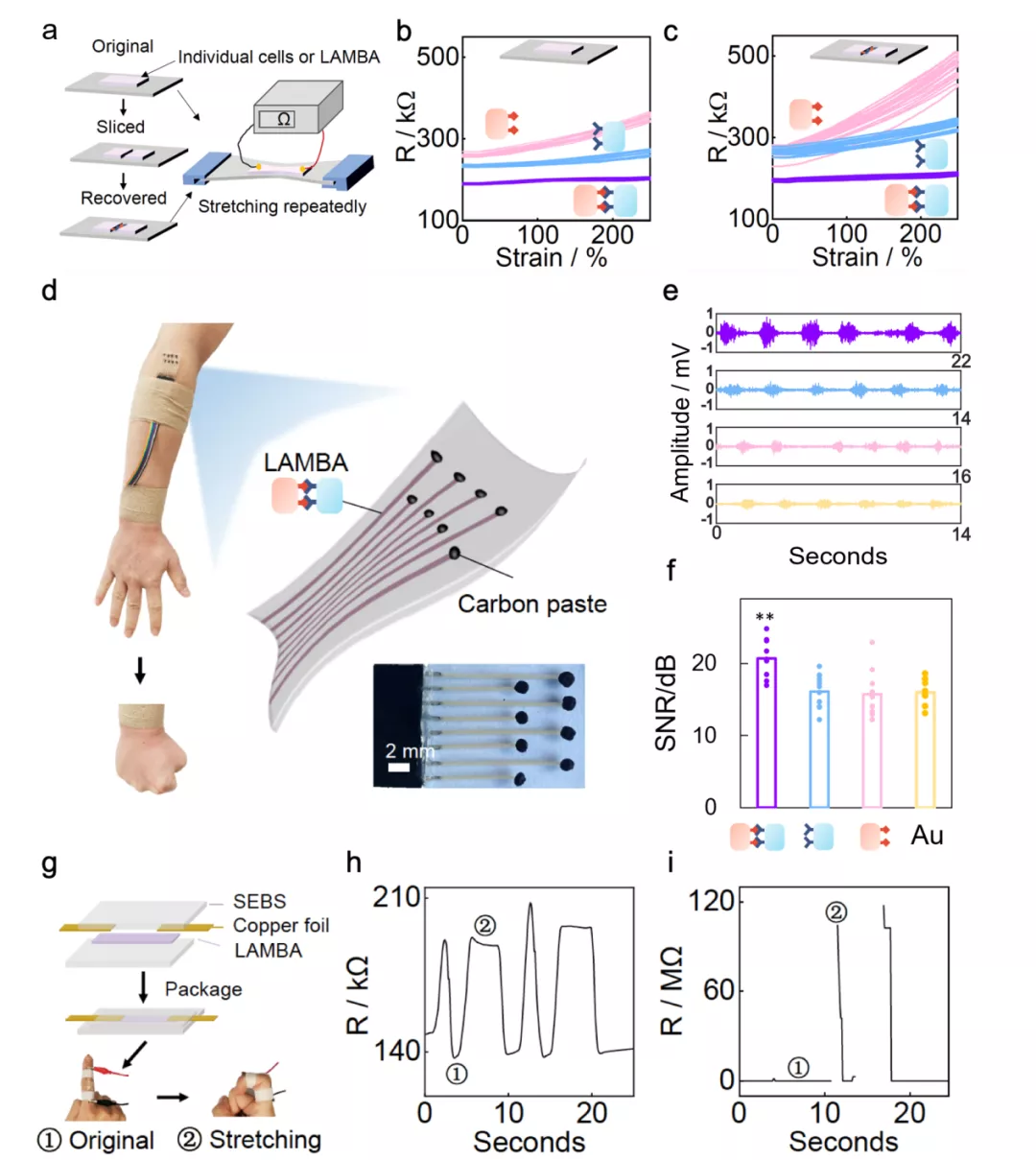 Figure 4: Wearable LAMBA flexible device. a: Experimental design for testing the self-healing of LAMBA; b: before cutting; c: after cutting and kneading, LAMBA (purple) maintains the resistance stability of 250% length and 10 cycles of stretching; d: flexible LAMBA Physiological sensor; e: Muscle electrophysiological signal in fisted and relaxed state, from top to bottom are flexible LAMBA, Nb, Ag, Au electrophysiological sensors; f: Signal-to-noise ratio of muscle electrophysiological signal corresponding to E picture, SNR =20 lg (ASignal /ANoise); g: flexible LAMBA strain sensor; h: flexible LAMBA strain sensor can stably monitor knuckle bending; i: flexible gold film strain sensor cannot monitor large-angle joint movement.
Figure 4: Wearable LAMBA flexible device. a: Experimental design for testing the self-healing of LAMBA; b: before cutting; c: after cutting and kneading, LAMBA (purple) maintains the resistance stability of 250% length and 10 cycles of stretching; d: flexible LAMBA Physiological sensor; e: Muscle electrophysiological signal in fisted and relaxed state, from top to bottom are flexible LAMBA, Nb, Ag, Au electrophysiological sensors; f: Signal-to-noise ratio of muscle electrophysiological signal corresponding to E picture, SNR =20 lg (ASignal /ANoise); g: flexible LAMBA strain sensor; h: flexible LAMBA strain sensor can stably monitor knuckle bending; i: flexible gold film strain sensor cannot monitor large-angle joint movement.
Wearable devices are designed to detect basic physiological signals of the human body in order to achieve the effects of daily health detection and auxiliary rehabilitation treatment.
Stretching conductivity is one of the key factors for the normal operation of the device.
Based on the above high tension cycling stability test bacteria, researchers LAMBA further sensor is used to prepare a wearable device comprising a flexible LAMBA electro-physiological sensor (LAMBA EMG sensor) and a strain sensor (LAMBA Strain Sensor) .
Electrophysiological sensors are used to record the electrophysiological signals of muscles during exercise (Figure 4d) .
The neuromuscular activity of the human body is accompanied by the generation of electrophysiological signals.
The frequency and amplitude of different neuromuscular electrophysiological signals are different, and the physiological characteristics and application ranges are also different.
The accurate acquisition of muscle electrical signals can be used to assess the health of muscles on the one hand, and on the other hand it can also be used to calculate and evaluate the instantaneous action intention of the human body, and then to control external devices, such as prostheses and exoskeleton.
The experimental results show that the flexible LAMBA electrophysiological sensor can capture the electrical signals of the muscle, and it shows a better signal -to- noise ratio than the single bacteria or gold film electrophysiological sensor prepared by the same method (Figure 4e-f) .
On the other hand, the high stretchability and self-healing characteristics of LAMBA show unique advantages in strain sensors.
Scientists encapsulate LAMBA to construct resistive strain sensors, and attach the sensors to the finger joints to monitor the deformation signals during bending. (Figure 4g) .
Experimental data shows that the flexible gold film strain sensor with micro-crack structure has signal interruption when the finger is bent (Figure 4i) , while the flexible LAMBA strain sensor constructed from living materials can stably sense the movement of the knuckles and give it The corresponding signal output (Figure 4h) .
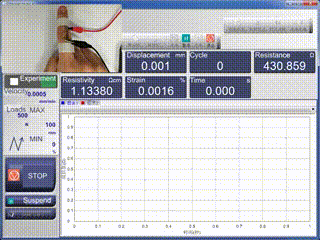
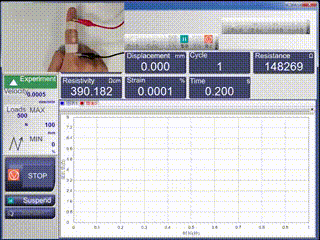
Figure 5: Strain sensors monitor knuckle bending. Top: flexible gold film strain sensor, bottom: LAMBA strain sensor
During the bending of the knuckles, the closer the joints are, the greater the deformation of the sensor.
Based on this, the flexible gold film sensor with micro-crack structure causes the entire sensor to fail due to excessive deformation in some areas, that is, the flexible gold with micro-crack structure The thin film sensor cannot work normally under a large deformation angle (Figure 5-top) .
In contrast, the flexible LAMBA strain sensor can cope with this uneven deformation, and react to the knuckles’ bending angle and movement retention state in real time through resistance changes (Figure 5-bottom) .
LAMBA Outlook: BT+IT
This work jumped out of the traditional design framework such as the living material editing amyloid system , and used the repair mechanism of a class of self-healing polymers through dynamic non-covalent bonding to build a new framework for rapid self-healing living material assembly.
1) Introduce the dynamic non-covalent concept of a class of self-repairing polymers into engineered microorganisms , and use the non-covalent binding force between the antigen-antibody to construct a living functional material that can quickly self-repair;
2) Through the surface display system, the large protein can modify the surface of bacteria , and improve the processability and programmability of living functional materials ;
3) Use living body functional materials to construct sensors, etc. and apply them to wearable devices that are frequently stretched or bent to monitor health indicators such as muscle electrical signals.
This work has important theoretical guidance and practical application significance for obtaining living materials with rapid repair capabilities.
Its attempts in the application of intelligent manufacturing in the IT field show the infinite possibilities of synthetic biology in the IT field and open up new ideas and new directions for the research of synthetic biology materials.
Expert Reviews
Fan Chunhai , academician of the Chinese Academy of Sciences and professor of Shanghai Jiaotong University : This work has taken a big step in the design and editing of living materials.
In particular, the innovative design idea of rapid self-healing mediated by dynamic non-covalent bonds in polymer physics and chemistry is used to arm bacteria, and the classic system accumulated in polymer science is introduced into synthetic biology across disciplines.
This also reminds us that we can learn and learn from other excellent systems of material science in the design of living materials in the future.
Zhao Guoping , academician of the Chinese Academy of Sciences and chief scientist of the Institute of Synthetic Biology, Shenzhen Institute of Advanced Technology, Chinese Academy of Sciences : This achievement focuses on the field of living functional materials and challenges the problem of self-healing within minutes of living materials that cannot be achieved by simply relying on cell division.
The inspiration for solving this problem is derived from the theory of rapid self-healing by the formation of dynamic non-covalent bonds.
Using the properties of the adhesive antigen-antibody mounted on the surface of bacteria, a functional material that can quickly assemble and self-heal has been developed to realize a brand new Programmable material mode.
It is particularly worth mentioning that this work further assembles living materials with a variety of wearable devices, such as muscle electrical signal sensors and strain sensors, breaking the boundary between living and non-living devices, and expanding the construction framework of living materials This is an example of “convergent” research on the intersection of chemical biology and biotechnology with materials science and engineering science.
Paper link:
https://www.nature.com/articles/s41589-021-00934-z
Nature Chemical Biology: The collision between BT and IT?
(source:internet, reference only)
Disclaimer of medicaltrend.org
